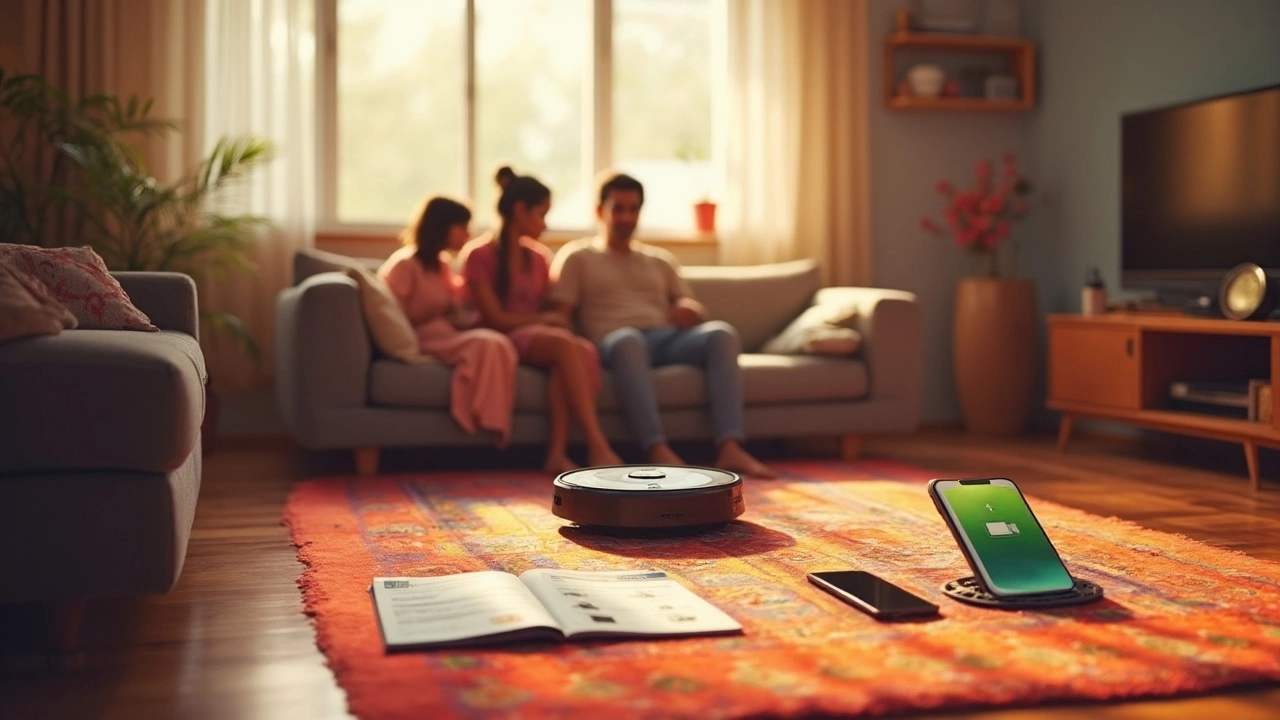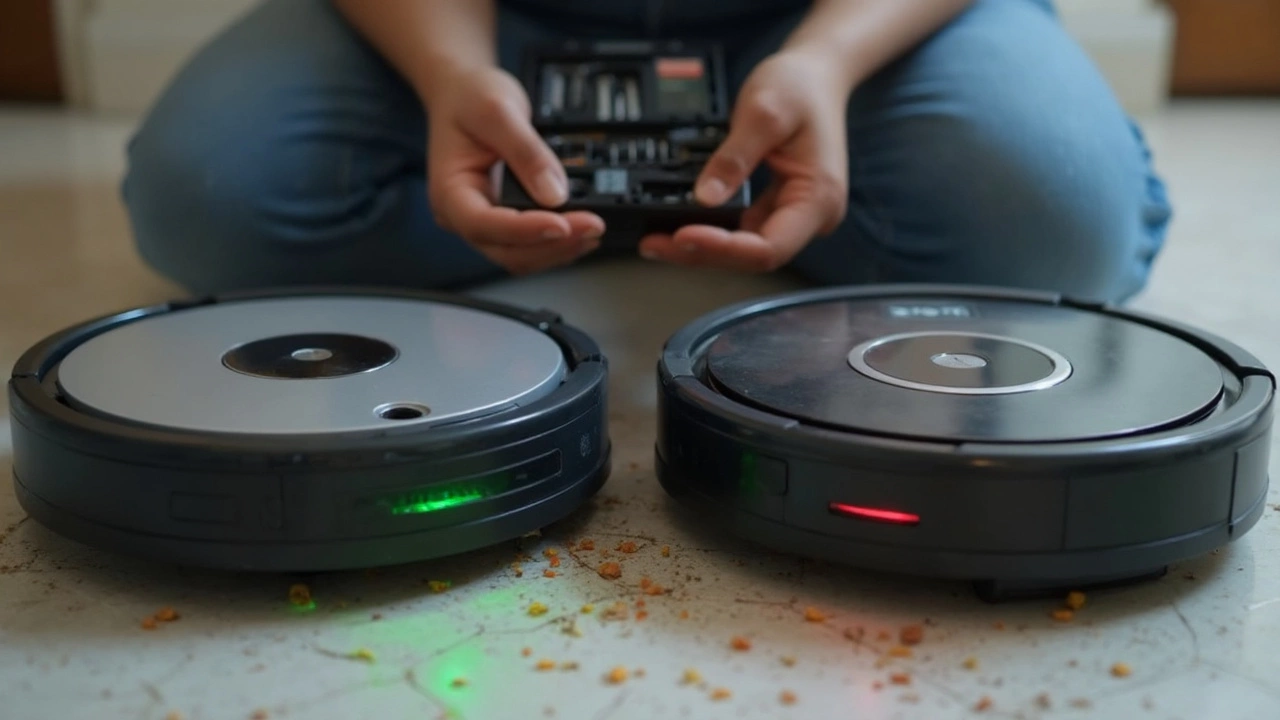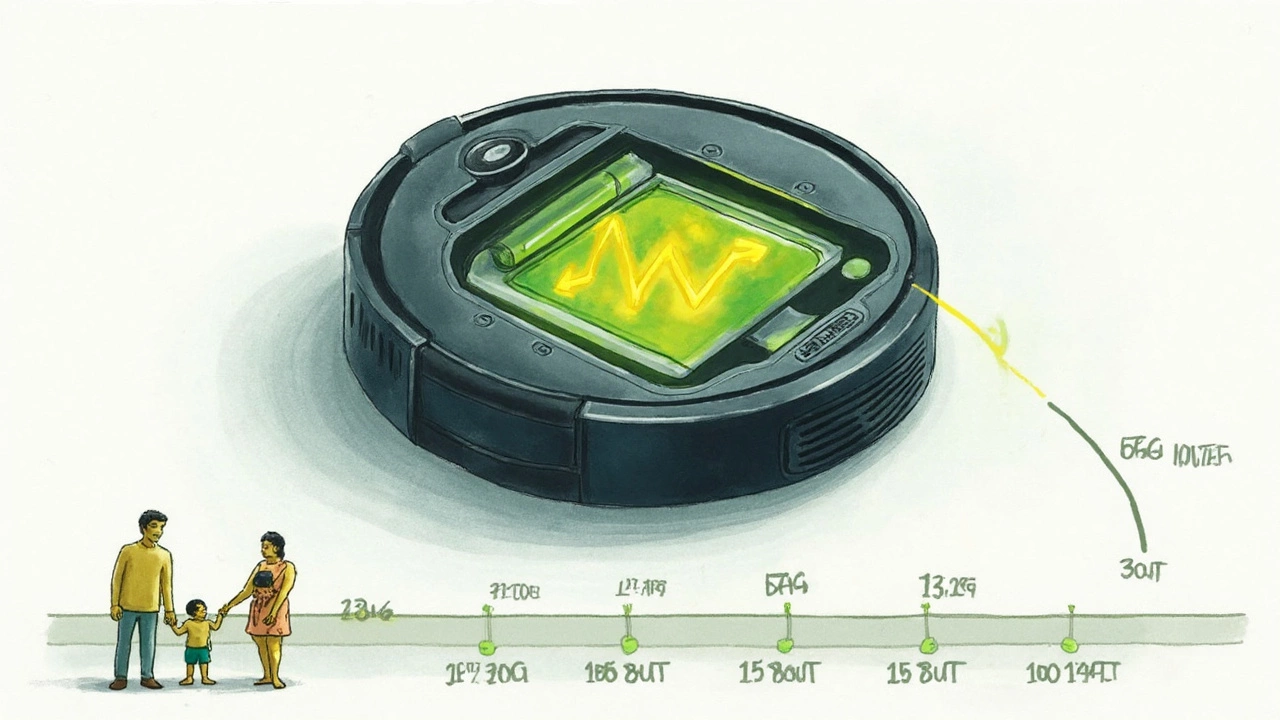
Here's a fun fact: most Roomba batteries don’t just croak after a couple years. With normal use, you can usually count on your Roomba’s battery to last anywhere from 2 to 4 years. Of course, that really depends on how you treat it and what type you have tucked inside—older nickel metal hydride (NiMH) batteries typically age out faster than the newer lithium-ion ones.
People are often surprised by how much a Roomba’s battery life has to do with little everyday habits. Letting yours sit on its dock for weeks without running, or always pushing it to run until it’s fully drained, actually does more harm than good. One real Roomba owner told me his robot lasted close to five years just because he ran it on a schedule, cleaned the brushes, and didn’t leave it gathering dust in a closet between uses.
- Typical Roomba Battery Lifespan
- What Impacts Roomba Battery Longevity
- Signs Your Roomba Battery is Wearing Out
- How to Make a Roomba Battery Last Longer
- When & How to Replace the Battery
Typical Roomba Battery Lifespan
So, how long can you actually expect a Roomba battery to last before you’re shopping for a new one? For most models, the answer lands between 2 and 4 years if you use and charge them normally. If you’re running your robot almost daily, you’ll probably be looking at the shorter end of that. With less frequent use, or if you take good care of your robot vacuum, it may even stretch out past four years.
The type of battery inside plays a big role. Early Roomba models used nickel metal hydride (NiMH) batteries, which generally wear out a bit sooner—think about 1.5 to 2.5 years. Newer models almost always use lithium-ion (Li-ion) batteries, known for both a longer life and better performance per charge.
Here’s a quick rundown showing average lifespans you can expect depending on usage and battery type:
| Battery Type | Average Lifespan | Model Examples |
|---|---|---|
| NiMH | 1.5 – 2.5 years | Roomba 600/700 Series |
| Li-ion | 2 – 4 years | Roomba 800, 900, i, j, s Series |
This means the average owner gets at least 300 to 400 complete cleaning cycles out of their battery before it really starts losing juice. For most folks, that’s a couple years of not thinking about batteries at all. If you want to get the most out of your Roomba battery life, how—and how often—you use it can make a real difference.
What Impacts Roomba Battery Longevity
If you want to squeeze every bit of life from your Roomba battery, knowing what actually wears it out makes a huge difference. Not all batteries face the same struggles, and some habits can age them fast.
The Roomba battery life really hinges on a handful of simple things:
- Type of battery: Most Roombas today use lithium-ion batteries, which outlast the old NiMH models. Lithium-ion holds charge longer and survives more charging cycles—think 300-500 full charges versus about 150-200 for NiMH.
- How often you run it: More cleaning cycles mean more charging and eventually more wear. If you run the Roomba daily, the battery will wear out faster than with a two or three times a week schedule.
- Charging habits: Letting the battery drop to zero before every charge strains it, especially for lithium-ion batteries. Topping it off before it fully drains helps.
- Storage conditions: Roombas don’t like being hot or freezing. Leaving your vacuum in a garage or stuffy closet speeds up battery aging. Ideal storage temp? Around 20°C (68°F).
- Maintenance: Gunked-up brushes and dirty filters make the motor work harder and the battery drain faster. Keeping your Roomba clean lightens its workload.
Check out this quick table to see what helps and hurts Roomba battery longevity:
| Factor | Good for Battery? | Notes |
|---|---|---|
| Using daily | No | Wears battery quicker |
| Storing at room temp | Yes | Prevents battery damage |
| Letting fully drain every time | No | Shortens battery life |
| Cleaning after each use | Yes | Reduces battery strain |
| Charging after each cycle | Yes | Best for lithium-ion |
Even little changes in your Roomba routine can end up making years’ worth of difference to the battery. Next time you stash it, skip that unheated shed, and wipe down the brushes once a week. Easy wins that pay off long-term.

Signs Your Roomba Battery is Wearing Out
A dying Roomba battery rarely quits all at once. You’ll usually spot the warnings long before it throws in the towel. Knowing what to look for helps you avoid being surprised when your robot vacuum suddenly stops cleaning your floors.
Here’s what most people notice as their Roomba battery life goes downhill:
- Shorter Cleaning Times: If your Roomba runs for only a few minutes or less when it used to clean for over an hour, something’s up. Weak batteries just can’t hold a charge like they used to.
- Won’t Return to Dock: Your Roomba is supposed to make it back to its dock to recharge. If it runs out of juice in the middle of a room and just sits there, the battery’s capacity has probably dropped.
- Flashing Red or Battery Warning Light: Most models flash a red light or show a battery icon when there’s an issue. If your Roomba starts to flash warnings shortly after leaving its dock, the battery might be on its last legs.
- Longer Charging Times: Older batteries often take way longer to charge, but die just as fast (or even faster) than before. If your Roomba is spending half its life charging, it’s a red flag.
- Odd Noises or Sudden Stops: Sometimes, a Roomba with a tired battery will stop and beep unexpectedly, even in the middle of a clean room. That random pause can signal the battery is struggling to deliver power.
If you spot any of these, especially if your Roomba is more than two years old, you’re probably not imagining things. New batteries don’t just bring the run time back—they make your robot vacuum act like it did when you first unboxed it. So don’t wait for a total shutdown before deciding to take action.
How to Make a Roomba Battery Last Longer
If you want to stretch out the life of your Roomba battery, a few easy changes in how you use and care for it really do help. These robot vacs aren't too fussy, but a little attention can save you money on replacements. Below are some proven ways to keep your battery running strong well past that second or third year.
Roomba battery life is mostly about smart habits. Here’s what owners and experts say actually works:
- Don’t let the battery fully drain every time. Lithium-ion batteries really hate going completely dead. Try to send Roomba back to its dock before it runs out juice if possible, or keep it on a cleaning schedule so it returns to recharge automatically.
- Keep it on the dock when not cleaning. Roombas are designed to live on their home base. This keeps the battery topped up—just don’t unplug the dock for days at a time, since letting the battery drop too low can hurt long-term health.
- Clean the brushes and filters often. The more hair and gunk your Roomba has to fight, the harder it works and the more power it uses. After every few runs, pop out the brushes and shake out the filter so it moves easy.
- Store it in a cool, dry place. High temperatures fry batteries—literally. Don’t leave your Roomba in a hot garage or by a sunny window. Harbor it somewhere cool and don’t let it freeze, either.
- Use only the official charger and battery. Cheap knockoffs might save a buck now, but they can seriously damage your robot later. Stick with gear made for your model.
Here’s a quick look at how these habits impact battery stats according to iRobot and feedback from frequent Roomba users:
| Habit | Expected Battery Lifespan |
|---|---|
| Proper use and regular cleaning | 2.5 - 4 years |
| Occasional cleaning, runs battery dry | 1.5 - 2 years |
| Stored in hot or cold environment | Under 1 year |
| Uses cheap, off-brand replacements | Unpredictable, often under 1 year |
And remember, if your Roomba is sitting unused for a month or more, give it a full charge every so often instead of letting it fade away. These simple habits aren’t rocket science, but they do make a real difference in how long your Roomba battery stays alive and kicking.

When & How to Replace the Battery
You’ll know it’s time to swap out your Roomba’s battery when it just won’t hold a charge or groans to a stop before finishing even a small job. If you notice your robot’s cleaning time dropping to under 15 minutes or the "docking" or "battery" lights acting odd, don’t ignore it. Usually, battery issues pop up after 2 to 4 years, depending on how often you use your Roomba and how you treat it.
Roomba battery life depends a lot on the model and battery type. For example, iRobot’s lithium-ion batteries (the ones used in most Roomba 900, i7, j7, and s9 series) often last longer than the older NiMH batteries from the 600 and 700 series. Here’s a quick snapshot of battery lifespans by type and series:
| Roomba Series | Battery Type | Average Lifespan |
|---|---|---|
| 600/700 Series | NiMH | 1.5 - 3 years |
| 800/900/i7/j7/s9 Series | Lithium-ion | 2 - 4 years |
So, how do you actually replace the battery? Even if you’re not handy, this is one home repair you can totally pull off. Here’s the play-by-play for most models:
- Flip your Roomba upside down and remove the side brush (if it blocks the cover). Usually, there’s just one screw.
- Unscrew the battery door (usually 2 or 4 screws) and pop off the cover.
- Lift out the old battery. Pay attention to the orientation. Roomba batteries are shaped to only fit one way, but it’s always good to check.
- Drop in the new battery. Make sure it clicks or seats firmly into place.
- Put the cover and side brush back on, then tighten the screws. Easy.
One tip: Stick with genuine iRobot batteries or a high-rated third-party battery from a known brand. Cheap knockoffs save money up front but might not last and can mess with warranty support.
After swapping out your battery, charge your Roomba fully before letting it loose again. If your robot doesn’t wake up or charge, double-check the battery’s position and those screws.
If your Roomba keeps acting up after a fresh battery, it could be a sign of another issue—like dirty charging contacts, a dead power adapter, or something wrong with the robot itself.